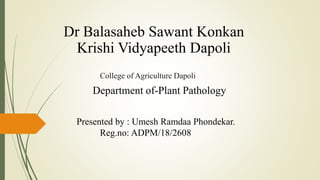
Presentation1
- 1. Dr Balasaheb Sawant Konkan Krishi Vidyapeeth Dapoli College of Agriculture Dapoli Department of-Plant Pathology Presented by : Umesh Ramdaa Phondekar. Reg.no: ADPM/18/2608
- 2. Course Title :- Plant Virology Name of topic – Introduction to plant viruses Presented to – Dr. A .P. Suryawanshi Sir
- 4. Introduction • Viruses are infectious pathogens that are too small to be seen with a light microscope, but despite their small size they can cause chaos. • The simplest viruses are composed of a small piece of nucleic acid surrounded by a protein coat. • As is the case with other organisms, viruses carry genetic information in their nucleic acid which typically specifies three or more proteins. • All viruses are obligate parasites that depend on the cellular machinery of their hosts to reproduce.
- 5. • Viruses are not active outside of their hosts, and this has led some people to suggest that they are not alive. • All types of living organisms including animals, plants, fungi, and bacteria are hosts for viruses, but most viruses infect only one type of host. • Viruses cause many important plant diseases and are responsible for losses in crop yield and quality in all parts of the world.
- 7. History • The beginnings of plant virology date back to the late 19 th century, when Dutch microbiologist Martinus Beijerinck and Russian researcher Dmitrii Iwanowski were investigating the cause of a mysterious disease of tobacco . • Tobacco mosaic virus (TMV), was the first virus to be described. • Since then, a large number of diverse viruses have been found in plants, animals, fungi, and bacteria. • The current estimate of recognized viruses is approaching 4,000, of which about 1,000 are plant viruses
- 8. • The main reason that we study plant viruses is the negative impact that viral diseases have on crop production. • Historically, viruses are perceived as a health threat to humans, livestock, and crop plants. • However, recent progress in understanding virus-host interactions has transformed viruses into important tools of biomedicine and biotechnology. For instance, plant viruses are being used to produce large quantities of proteins of interest in plants (Pogue et al. 2002) and to develop safe and inexpensive vaccines against human and animal viruses (Walmsley and Arntzen 2000).
- 9. Basic Biology • Viruses represent fundamentally different form of life. • Unlike all other living organisms, viruses are non-cellular. • In contrast to cells, which multiply by dividing into daughter cells, viruses assemble from pools of their structural components. • Mature virus particles are dormant; they come alive and reproduce only inside infected cells. • In other words, viruses are obligate parasites that cannot be cultivated using any growth media suitable for bacterial, fungal, plant or animal cell types.
- 10. • All viruses lack protein-synthesizing and energy-producing apparatuses. • As a rule, virus particles are immobile outside the infected host; they rely on the aid of other organisms or the environment for their dissemination.
- 11. Morphology • Virus particles (virions) are composed the genome that is made of nucleic acid, and a protective shell that is made of protein. • In addition, some virus particles are enveloped by an outer membrane containing lipids and proteins (lipoprotein membrane). • The protein shells of plant viruses (capsids) are assembled in accord with one of the two fundamental types of symmetry.
- 12. Genome of viruses • As in other organisms, the information for virus reproduction is contained within its genome . • only a minority of plant viruses possess dsDNA genomes. • Some of the plant viruses have genomes that are composed of single-stranded (ss) DNA. • The genomes of nearly all plant viruses are made of RNA. • Most of these genomes are composed of ssRNA that is the same (positive-sense) polarity as the messenger RNAs of the cell.
- 13. • Due to variation in the nature of the genetic material of viruses, the reproductive cycles and life styles of different viruses are often very distinct from each other. • Since plant viruses are obligate, biotrophic parasites, their life cycles start by penetration of the virion into the cell. • Plant viruses are unable to penetrate the plant cuticle and cell wall. • It is believed that the virion enters the cytoplasm of the cell passively through wounds caused by mechanical damage to the cuticle and cell wall.
- 14. Plant-Virus Interactions • Viruses are capable of infecting all species of cultivated and wild plants. • However, host ranges of individual viruses vary from very narrow to very broad. • For instance Citrus tristeza virus infects only a few species in the Citrus genus, whereas Cucumber mosaic virus infects over 1000 species in 85 plant families. • Susceptibility or resistance of plant species and cultivars to viruses is determined primarily by the plant genotype. • Plants possess active and passive means of preventing virus infection. • Passive defenses are due to the failure of the plant to produce one or more host factors required for virus reproduction and spread within the host.
- 15. • Active defenses include detection and destruction of the virus-infected cells due to the function of specific resistance genes in the plant. • Normally, resistance genes are active only against a particular virus. • In addition, plants possess a general defense system that is somewhat analogous to the animal immune system. • The major difference between the two is that the immune system in animals targets a pathogen’s proteins, whereas the plant defense system, which is called RNA silencing, detects and degrades viral RNAs .
